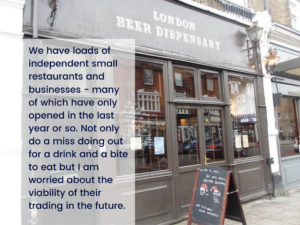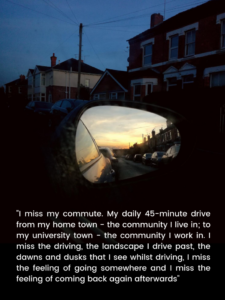With the lockdown exit strategy due to be announced by the Government on Sunday, we were curious to find out what UK residents think is the best way to lift lockdown – so we asked people keeping diaries as part of our Covid & Me study to tell us what they would do if they were in charge of deciding how the country might relax social isolation measures over the coming weeks.
The majority of participants in our study would prefer to remain in lockdown rather than risk a second wave of infections. This is in line with research by Ipsos Mori which found that Britons, compared to residents in 13 other countries, are the least likely to want the economy and businesses to reopen if the virus is not fully contained. Arthur commented, “I would be waiting until the number of new cases had declined massively, which could easily be 2 or 3 months.” And Zenaida said, “As the UK is on its way to [being] the second country with the most recorded Covid-19 deaths at the moment, I think it’s not the time to ease any lockdown yet. I would be looking at September 2020 for a review.”
Towards normality
While there are many concerns about how lockdown can be lifted safely, there is an increasing desire to move towards normality. There is lots that people miss about life before the pandemic, from the small pleasures in life, to the more essential, including employment, childcare or access to important health services.
Most people agree that a staggered approach is the way forward, but the priorities for each phase of a staggered strategy are based on each individual’s current situation and perception of risk.

Some say the lockdown exit strategy should start with small businesses being reopened. Liz said, “Where it is not possible to work from home businesses should reopen with as small team as possible working to allow social distancing. Businesses that are operating with staff all working from home should stay that way.”
For others, children should first be allowed to go back to school. Marianne commented, “I would start schools up again in June […]. They were open until just before the lockdown and this didn’t appear to exacerbate the spread. It is important for children’s wellbeing to have that type of normality. This could be with some social distancing, eg around how children are dropped off and collected.”
Proceed with caution
The caution people feel is reflected in the conditions they feel should be fulfilled prior to easing the lockdown. Most frequently they want to see:
- Nationwide testing – “We absolutely have to have testing available to everyone. Decisions cannot be made without this,” Elizabeth,
- Track and tracing technologies Most simply want the basic app to have widespread uptake, but others would be keen to go further: “Closely monitor people while they interact in the public sphere: To then be allowed out you would need to be wearing a smart watch with thermometer and be monitored, also carrying a smartphone with blue tooth contact recording to allow contact tracing if required,” Arthur.
- Lower daily infection and death rates – “As the daily deaths are still around the 700 mark and daily new infected persons still around 5000 it make no sense to me to ease the restrictions in place,” Zenaida.
- Reliable PPE supply for frontline staff – “I would be making sure that all frontline workers have the correct PPE that is vital for them to do their work safely, this is the least thing that we can do,” Junakhi.
- Compulsory face makes worn in public – “The compulsory wearing of masks in public places (and gloves in some instances) would aid the containment of contagion in these early phases… Education for the public is needed about safe use of masks and gloves,” Michelle.
Life after lockdown
This is particularly marked by a general worry that when lockdown measures are eased, it will become impossible to control people’s movements which in turn would result in irresponsible behaviour. Liz said, “I am concerned that there will be a rush to leisure and social activities and cannot think how this can be controlled. Somebody said it was going to be much more difficult to reopen things than it was to close them.”
Michelle believes that this could be leveraged by opening certain areas one by one, “One option might be to ease restrictions on an area by area basis, so as to ‘test the waters’, but also to avoid a sudden mass cross-country migration of people who are eager to visit family or second homes.”
Disagreement appears to be highest regarding social gatherings and leisure activities. While some think this should be the last step of an exit plan as it is non-essential, others believe that allowing people to meet family and friends is necessary for people’s mental health and wellbeing “I think my strategy would probably focus first on allowing more social interactions between people because I think this is most important for people’s wellbeing,” said Raina – in the knowledge that she has already, like many others, given in to the temptation to meet up with loved ones. “I have ‘broken’ the lockdown rules. My boyfriend cycled to my house and we went for a walk. It felt ‘wrong’ and I couldn’t fully relax with the situation so I tried to put it off as much as I could. I really wanted to see him, but was very stressed out at ‘breaking the rules’ which is something I don’t do and all the negative news around all the people breaking the rules and ‘risking lives’.
There is a strong consensus that offices should be the last to be reopened, as working from home – for the most part – has not proven detrimental to business for many industries. “People that can work from home last to go back to offices. The ones that need to work like factories etc go back but rules of social distancing and masks in place,” said Sofia.
There is uncertainty around how to best protect people most at risk in the months ahead and some feel that not enough attention has been directed towards care homes. John commented, “Understandably, there was a big focus on hospitals, setting up extra facilities such as the Nightingale… but what looks like an equally big neglect of what was happening in care homes, despite the fact that it was known the elderly were in the most vulnerable category”.
Messages to government
People are vocal about their frustrations around the Government’s slow response at the beginning of the crisis and a lack of transparency throughout the pandemic. Louise says the government should “just be honest about what’s working and what’s not working.” There are strong voices demanding that the Government learns from its detrimental decision to delay the lockdown in the beginning and looks more towards the approaches taken by other countries – what has worked and what hasn’t – when deciding on the UK’s exit strategy. “I would be following the progress of other countries who are ahead of us in this pandemic and I would base my decisions on what has worked for them,” said Eleanor.
Additionally, there are demands for the UK Government to work collaboratively with other countries, as people feel many nations across the world have adopted an ‘each-to-their-own’ approach, when they should have been sharing learning to help their citizens. John added, “Government (as it seems to be trying to do now) should have encouraged and/or coordinated a more cohesive international response… Instead we have league table of each country’s statistics dominating the news. And an increase amount of international mud-slinging”.
Yet there is also hope that the exit strategy is an opportunity to rethink old structures and systems rather than return to the old pre-Covid ways of doing things. This is particularly true for issues around the environment. “Any strategy must be low-carbon at its heart – this is an opportunity to address the biggest threat facing us,” said Fiona. John agreed: “I hope the people in Government who are looking at what the ‘new normal’ will look like are applying imagination and creativity and long term thinking when creating their vision. And looking at what has emerged from this situation that has been positive – for example, a huge reduction in CO2 emissions”.

Community COVID-19 Posted on: 7 May 2020 Authors: Franca Roeschert, Jana Tauschinski,
